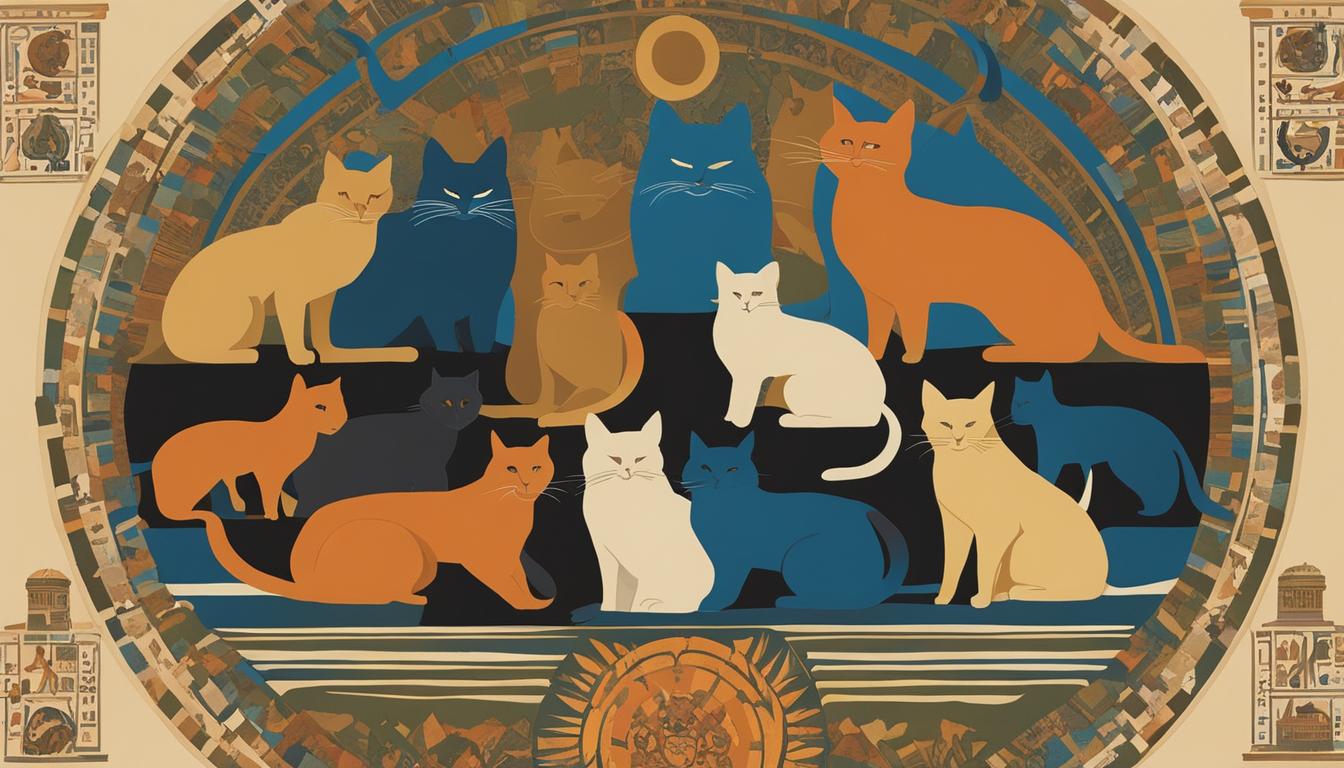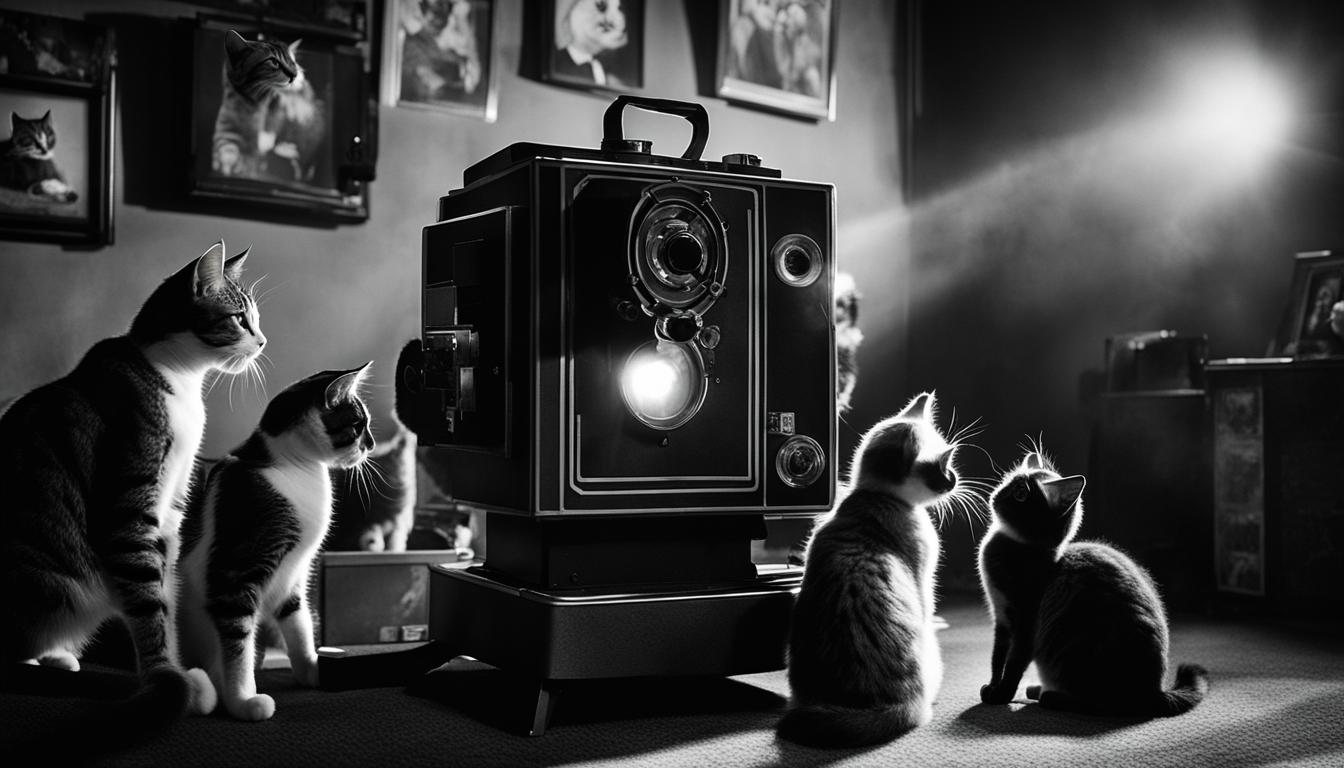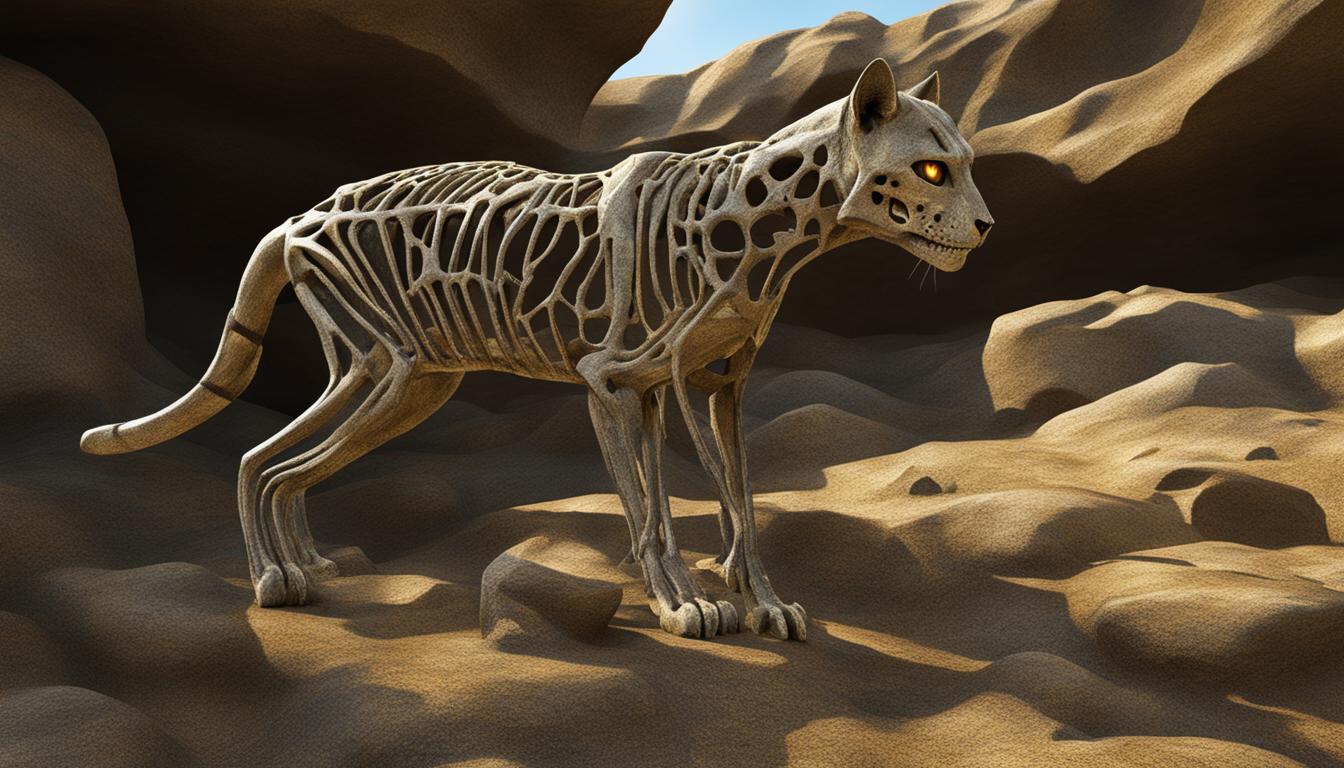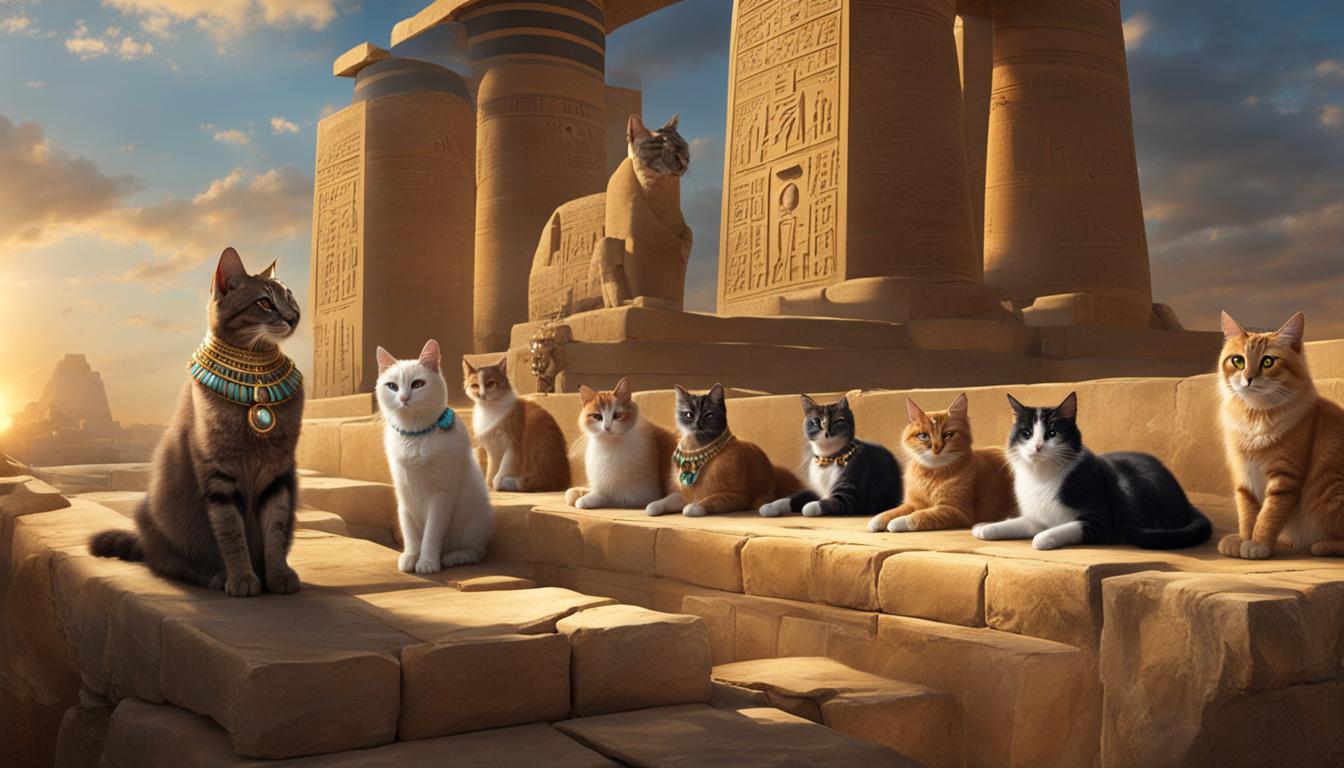Welcome to my exploration of cats in Norse mythology! As a lover of feline companions and a curious journalist, I couldn’t resist delving into the intriguing world of Norse myths involving our whiskered friends. Cats held a special place in Viking legends, and their symbolism and significance in Norse society are truly captivating.
Cats played practical roles in Viking culture, accompanying seafarers on long voyages as skilled hunters. They were not only valued for their ability to control vermin on ships but also believed to possess supernatural powers, acting as protectors against evil spirits. Cats were closely associated with the goddess Freyja, a powerful figure in Norse mythology, and featured prominently in tales of gods such as Thor.
These furry creatures were more than mere animals to the Vikings. They held a deeper symbolic significance, representing strength, agility, and adaptability – qualities highly prized by the seafaring Norse people. Cats were not only practical companions but also spiritual guides, embodying the protective and mysterious forces present in Norse culture.
Key Takeaways:
- Norse mythology portrays cats as essential companions on Viking voyages, valued for their hunting skills and ability to ward off evil spirits.
- Cats in Norse mythology held symbolic significance, representing strength, agility, and adaptability.
- Goddess Freyja and other Norse gods were closely associated with cats, emphasizing their importance in the mythology.
- Cats adorned ships and buildings, invoking their protective powers and leaving a lasting legacy in Norse culture.
- Cats continue to hold significance in modern Scandinavian folklore, with the Norwegian Forest Cat considered a descendant of the Viking cats.
Vikings’ Furry Allies: Cats as Practical Companions on Viking Voyages
During their formidable voyages, Vikings relied on the companionship of their feline friends – cats. These furry creatures played a crucial role in Viking society, serving as practical companions and protectors on their long journeys at sea. Valued for their hunting skills and ability to keep vermin in check, cats were essential in maintaining the well-being of both the crew and their provisions.
But cats were more than just skilled hunters; they held significant symbolic importance in Norse ritual practices. Believed to bring blessings and ensure the safety of the crew, cats were regarded as harbingers of good fortune during Viking voyages. Their presence on board invoked a sense of protection and divine favor, fostering a belief in their supernatural powers.
“The cats were our constant companions, guardians against evil spirits on the treacherous seas,” said Erik the Bold, a legendary Viking explorer.
While cats were revered for their practicality and supernatural associations, they were also deeply intertwined with Norse mythology. Freyja, the Norse goddess of love, beauty, and fertility, had a close connection with cats. She was often depicted with her two magical cats, Bygul and Trjegul, symbolizing her association with these enigmatic creatures.
The Viking Beliefs About Cats
The Vikings held strong beliefs about cats, viewing them as protectors and bearers of good fortune. The presence of cats in Norse ritual practices signified an acknowledgment of their role in ensuring safe voyages. Cats were not only practical companions but also cherished for their supernatural powers, representing a bridge between the mortal and divine realms.
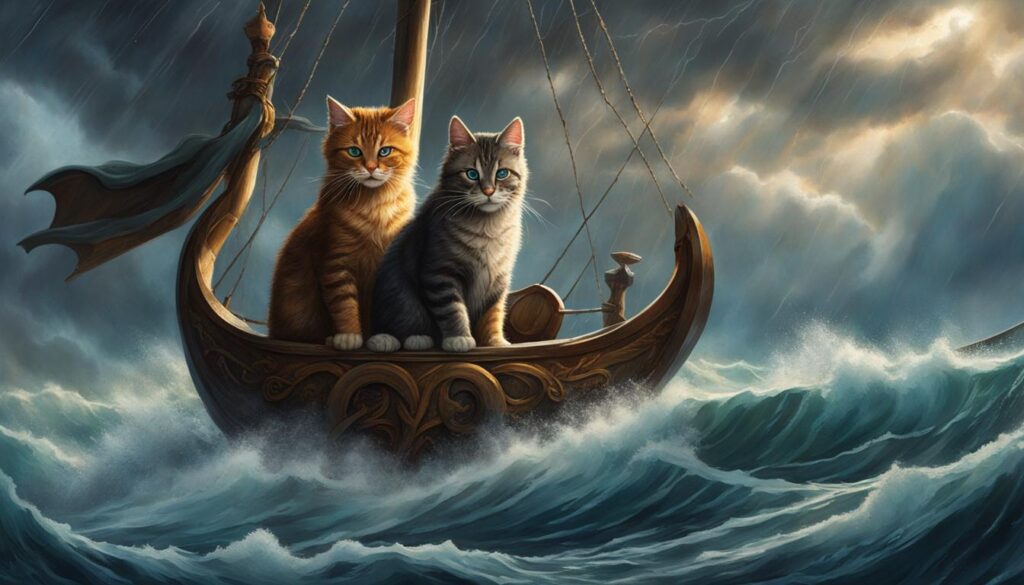
| Norse Mythological Cats | Viking Beliefs and Practices |
|---|---|
| Cats associated with the goddess Freyja | Symbolized protection, fertility, and love |
| Believed to possess supernatural powers | Acted as guardians against evil spirits |
| Ensured the safety of Viking voyages | Brought blessings and good fortune |
The Viking belief in the significance of cats extended beyond their practical use. Cats became a part of Norse artistic representations, adorning ships and buildings as symbols of protection. These depictions invoked the cats’ supernatural powers, reinforcing their role as guardians and bringers of good luck.
Throughout Viking culture, cats held a place of honor and reverence. Their practicality, supernatural associations, and symbolic representation made them integral to the belief system and daily lives of the Norse people.
Cats in Norse Mythology and Beliefs
Cats held a special place in Norse mythology and beliefs, representing both practicality and the supernatural. They were associated with the goddess Freyja, who was often depicted with her two magical cats, Bygul and Trjegul. These cats were believed to possess supernatural powers and act as guardians against evil spirits. Their presence brought good fortune and protection to their owners.
But it wasn’t just Freyja who had a connection to cats in Norse mythology. The mighty god Thor also had a memorable encounter with a cat in a myth. According to the story, Thor attempted to lift a giant cat, but the feline proved to be none other than the mighty Jormungandr, the giant serpent that encircles the world. This tale highlights the significance of cats in Norse mythology and their connection to powerful beings.
The Significance of Cats in Norse Artistic Representations
Cats were not only revered in Norse mythology but also played an important role in artistic representations. In Norse artwork, cats were often depicted adorning ships and buildings, serving as both decorative elements and symbols of protection. These artistic representations aimed to invoke the cats’ supernatural powers and bring good fortune to their surroundings. The presence of cats in Norse art showcases their symbolic importance in Viking culture.
| Cats in Norse Artistic Representations | Meaning |
|---|---|
| Carvings of cats on Viking ships | Symbolized protection during sea voyages |
| Cat-shaped figurines found in Viking graves | Believed to bring good fortune in the afterlife |
| Cat motifs on buildings and artifacts | Invoked cats’ supernatural powers for protection |
“The presence of cats in Norse art showcases their symbolic importance in Viking culture.”
The artistic representations of cats in Norse culture serve as a testament to the deep-rooted belief in their protective qualities. Whether through carvings on ships, figurines in graves, or motifs on buildings, the Norse people embraced the presence of cats in their daily lives and rituals. These depictions not only celebrated the practical aspects of cats as skilled hunters but also highlighted their connection to the supernatural and divine.
The significance of cats in Viking culture and Norse mythology is a testament to the longstanding bond between humans and these enigmatic creatures. From their practical role as companions on long sea journeys to their association with gods and goddesses, cats held a special place in Norse society. Today, their legacy continues in Scandinavian folklore, reminding us of the enduring influence of cats in our lives and the rich cultural tapestry of the Vikings.
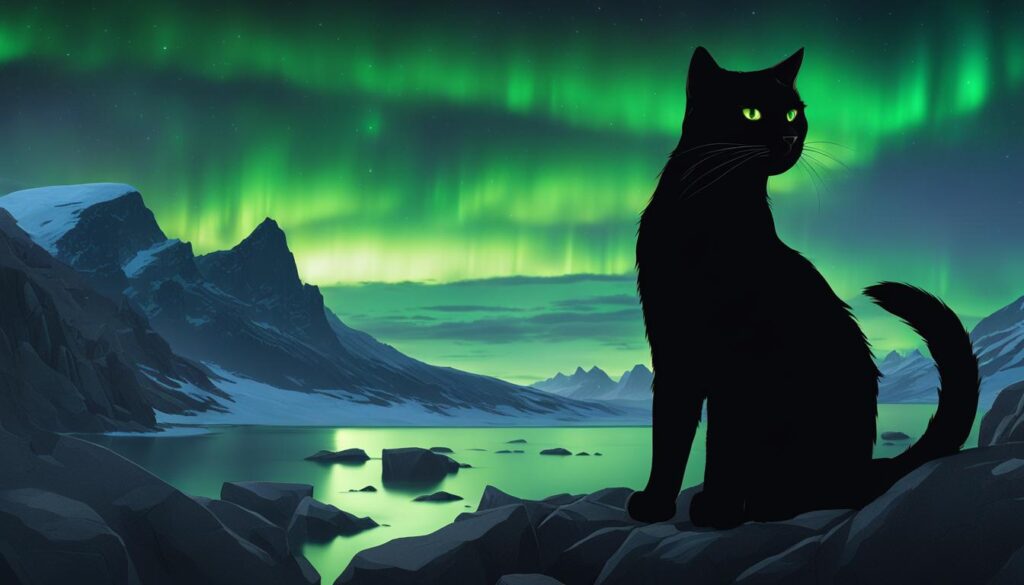
Cats in Scandinavian Folklore: The Enduring Bond with Vikings
Throughout history, cats have held a special place in Scandinavian folklore, particularly in their relationship with the Vikings. These seafaring warriors revered cats for their practicality and their symbolic significance. Cats were not only valued companions on long voyages, but they also represented strength, agility, and adaptability, qualities highly prized by the Norse people.
According to Norse mythology, cats served as protectors and guardians against evil forces. They were believed to possess supernatural powers and bring good fortune to their owners. Cats were closely associated with the goddess Freyja, who was often depicted with her two magical feline companions, Bygul and Trjegul. Their presence symbolized divine favor and ensured the safety of the Vikings during their travels.
“The Norse people embraced the presence of cats in their daily lives and artistic representations, using their images to invoke protection and blessings,” says Norse mythology expert [insert expert name]. “Cats were believed to watch over homes and ships, safeguarding them from harm and ensuring safe journeys.”
The influence of cats in Viking culture can still be seen today in modern Scandinavian folklore. One such example is the Norwegian Forest Cat, which is believed to be a descendant of the cats that once sailed with the Vikings. These majestic felines carry with them the legacy of their Viking ancestors and continue to be revered for their beauty, grace, and independent spirit.
| Cat Symbolism | Characteristics |
|---|---|
| Strength | Represented by their powerful hunting skills |
| Agility | Known for their quick reflexes and nimble movements |
| Adaptability | Able to thrive in various environments and conditions |
| Protection | Considered guardians against evil spirits |
| Good Fortune | Believed to bring blessings and ensure the safety of their owners |
As we delve into the rich tapestry of Norse mythology and Scandinavian folklore, it becomes clear that cats have long held a significant place in the hearts and minds of the Vikings. Their practicality as companions and their symbolic importance as protectors have solidified their status as enduring figures in Norse culture.
The Norse Cat’s Role and Influence in Viking Culture
The significance of cats in Viking culture cannot be overstated. These feline companions played a vital role in Norse society, serving as protectors and hunters, and held a symbolic importance that transcended practicality. As sacred animals associated with the goddess Freyja, cats symbolized protection, good fortune, and divine favor.
One of the most notable aspects of the Norse cat’s role in Viking culture is its connection to the goddess Freyja. Freyja, the goddess of love, fertility, and beauty, was often depicted with her two magical cats, Bygul and Trjegul. These cats were believed to be her companions and represented her connection to the supernatural realm. Their presence symbolized Freyja’s power, grace, and protection, making cats highly revered in Viking society.
“Cats held a symbolic significance, representing strength, adaptability, and agility.”
Moreover, cats were intricately woven into Norse artistic representations. Their images adorned Viking ships and buildings, serving as a visual invocation of their protective powers. These artistic depictions showcased the allure and majestic nature of cats, further emphasizing their significance in Viking culture.
The influence of cats in Viking culture continues to resonate in modern Scandinavian folklore. The Norwegian Forest Cat, with its striking resemblance to the cats that sailed with the Vikings, is believed to be a direct descendant. This connection to the past serves as a reminder of the enduring bond between humans and animals throughout history, and the lasting impact that cats had on Norse society.
The Norse Cat’s Role and Influence in Viking Culture:
| Significance | Description |
|---|---|
| Protectors | Cats served as protectors against evil forces and brought good fortune to their owners. |
| Symbolism | Cats represented strength, agility, adaptability, and were sacred to the goddess Freyja. |
| Artistic Depictions | Viking ships and buildings were adorned with cat images, invoking their protective powers. |
| Modern Folklore | The Norwegian Forest Cat is believed to be a descendant of the cats that sailed with the Vikings, keeping their legacy alive. |
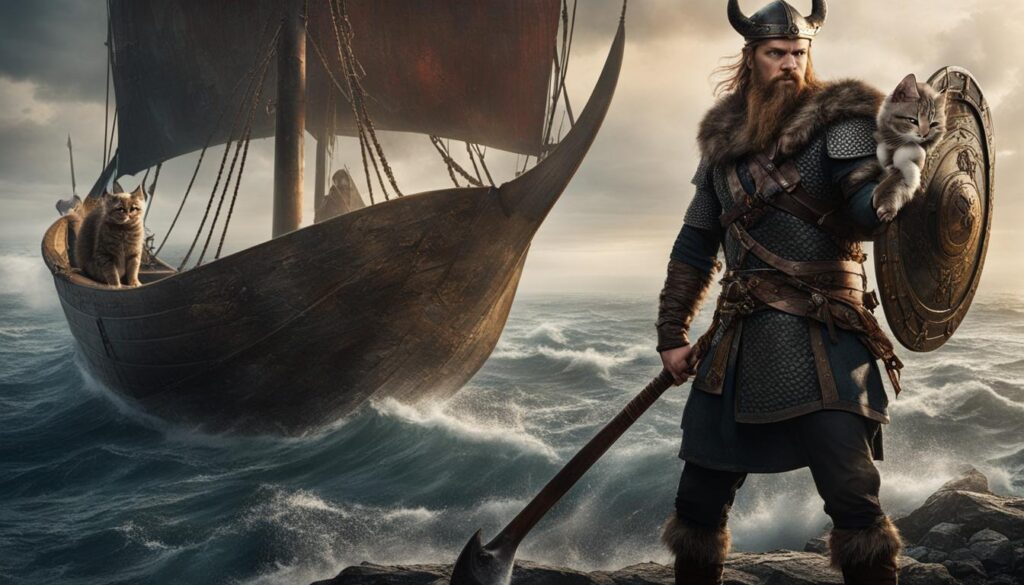
Overall, the Norse cat’s role and influence in Viking culture were multifaceted. From practical companions to sacred symbols of strength and protection, cats left an indelible mark on Norse society. Today, their legacy lives on in folklore and the descendants that continue to captivate us with their beauty and mystery.
Cats in Norse Mythology: A Guide to Viking Cats
The rich mythology of the Norse people is replete with references to cats, which held a sacred place in their beliefs and rituals. These feline creatures were not merely seen as ordinary animals but were considered deities in their own right. Freyja, the Norse goddess of love, beauty, and fertility, was closely associated with cats and was often depicted with her two magical feline companions, Bygul and Trjegul.
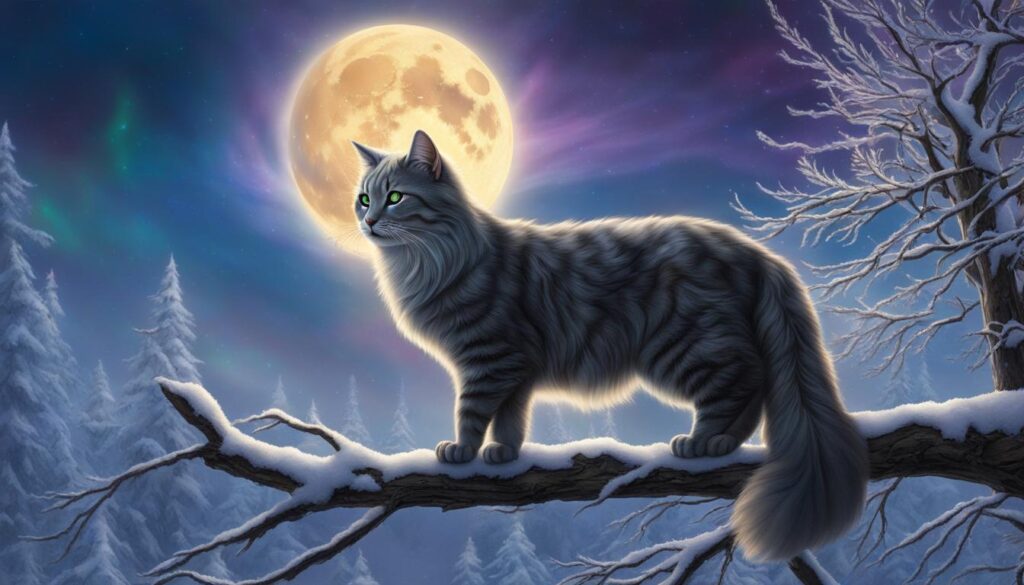
In Norse mythology, cats were believed to possess supernatural powers and to act as guardians against evil spirits. They were revered for their keen senses and their ability to ward off malevolent forces. Cats represented protection and good fortune, playing a vital role in the lives of the Norse people.
The Role of Cats in Norse Mythology
“The cats that prowled the land of the Norse were more than just hunting companions. They were seen as sacred beings, connected to the divine and possessing mystical qualities.”
The association between cats and Norse mythology extended beyond Freyja. Thor, the powerful god of thunder, once had an encounter with a cat, where he struggled to lift the creature, only to discover that it was actually the fierce Jormungandr, a giant serpent that encircles the world. This tale showcases the close connection between cats and the realm of gods in Norse mythology.
Cats also played a central role in Viking beliefs and rituals. They symbolized protection and were believed to bring good fortune to their owners. Viking ships and buildings were adorned with carvings and artwork depicting cats, invoking their protective powers during journeys and ensuring the safety of their inhabitants.
| Viking Beliefs About Cats | Norse Mythological Cats |
|---|---|
| Cats were seen as protectors and bringers of good fortune. | Cats were considered deities, with Freyja’s feline companions Bygul and Trjegul being prominent figures. |
| Viking ships and buildings were adorned with cat carvings to invoke their protective powers. | Cats possessed supernatural abilities and were believed to ward off evil spirits. |
| Cats symbolized strength, agility, and adaptability, qualities valued by the Norse people. | Cats played a significant role in Viking beliefs and rituals, representing protection and divine favor. |
The cats of Norse mythology continue to intrigue and fascinate us today. Their significance in Viking culture highlights the enduring bond between humans and animals throughout history, reminding us of the ancient connection between the natural and supernatural realms.
Conclusion
As I conclude my exploration of cats in Norse culture, it becomes clear that these furry companions had a profound significance in Viking society. Not only were they practical companions on long sea journeys, but they also played a central role in Norse mythology and rituals.
The cats that sailed with the Vikings were more than just hunters and protectors; they were symbolic representations of strength, adaptability, and agility. Associated with gods and goddesses like Freyja, Thor, and Odin, these cats were believed to possess supernatural powers and bring good fortune to those who revered them.
Today, the influence of these Norse mythological cats can still be felt in modern Scandinavian folklore. Their legacy endures, reminding us of the enduring bond between humans and animals throughout history. The significance of cats in Viking culture is a testament to the deep reverence and admiration the Norse people had for these majestic creatures.
FAQ
What role did cats play in Norse society and mythology?
Cats were practical companions on Viking voyages, valued for their hunting skills and ability to keep vermin at bay. They were also associated with the supernatural, believed to possess supernatural powers and act as guardians against evil spirits.
Which Norse goddess is closely connected to cats?
The Norse goddess Freyja is closely connected to cats. She is often depicted with her two magical cats, symbolizing protection and good fortune.
What symbolic significance did cats hold in Norse culture?
Cats represented strength, agility, and adaptability, qualities highly valued by the seafaring Norse people. They were seen as protectors of homes and ships, ensuring safe journeys and safeguarding against evil forces.
How did cats feature in Norse myths involving gods?
Cats were associated with various gods, such as Thor and Odin. They played roles in Norse myths, often acting as companions or symbols of protection and divine favor.
What is the legacy of Norse cats in modern Scandinavian folklore?
The Norwegian Forest Cat is believed to be descendants of the cats that sailed with the Vikings. Their importance and influence are still celebrated in modern Scandinavian folklore.


